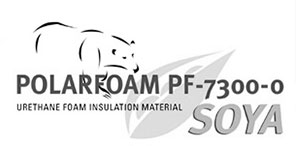There are two general categories of SPF insulation materials; open-cell, low-density (a.k.a. ‘half-pound foam’) and closed-cell, medium-density (a.k.a. ‘two-pound foam’). Both foam categories provide excellent insulation and air sealing. Although both are made using almost identical chemical reactions, there are some inherent physical property differences that often determine which product is chosen for a particular project.
Open-cell spray foam (ocSPF) has an open cell structure where the cells are filled with air. The open-cell structure renders soft, flexible foam, with a density of about 0.5-0.8 pounds per cubic foot (pcf). Still air is the primary insulation medium in ocSPF, fiberglass and cellulose. These insulations work by reducing the natural air movement within these materials thereby reducing the ability of the material to conduct heat. The R-value per inch of open-cell foam typically ranges from R3.6 to R4.5 per inch. Unlike fiberglass and cellulose, the fine cell structure of ocSPF makes it air-impermeable at certain thicknesses. The air-impermeability of ocSPF qualifies it as an air-barrier material, dramatically reducing air leakage through the building envelope, significantly lowering the building’s heating and cooling costs. ocSPF, like fiberglass and cellulose insulations, is moisture-permeable, and may require the installation of a vapor retarder in colder climates. .
Closed-cell spray foam (ccSPF) has a closed cell structure which yields a rigid, hard foam, with a density of 1.8-2.3 pound per cubic foot (pcf), and has been demonstrated to provide structural enhancement in certain framed buildings. These smaller cells trap an insulating gas, called a blowing agent. This blowing agent has a lower thermal conductivity than still air, and increases the R-value. Typical R-value per inch of closed-cell foam ranges from R5.8 to R6.9* per inch, making it a great choice in applications where clearance is limited. Like ocSPF, ccSPF is also air impermeable at certain thicknesses and and can qualify as an air-barrier material. The closed-cell structure of ccSPF makes it water-resistant, and is the only spray foam that can be used where contact with water is likely (e.g., below-grade concrete walls, in contact with the ground, or on exterior side of the building envelope). At a thickness of 1.5 inches, ccSPF has a moisture permeance typically less than1.0 perms and no additional vapor retarder is required for most applications.







